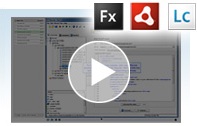|
|
|
| |
Adobe Flex/AMF requests
Overview
AMF is a binary, client-server data transfer protocol used by certain Adobe Flash applications. The optional AMF (Action Message Format) module allows load testing Adobe Flash applications developed using Adobe Flex technology, and using the AMF application protocol.
There are several variants of the AMF binary protocol:
- AMF0: This version is used in Flex applications written in ActionScript 1.0 and 2.0.
- AMF3: Adobe introduced this protocol, very similar to AMF0, from ActionScript 3.0 onwards. The protocol allows the exchange of objects created by the application developer between the client and server.
Managing AMF requests requires the purchase of the optional Adobe FLEX/AMF XML module. This module is included in the demo version of NeoLoad.
For more information, click the image below to see the Neotys video about Adobe Flex in NeoLoad:
Dependent libraries
When recording AMF3 requests, depending on the server-side implementation, the Java classes of the objects exchanged have to be declared in NeoLoad. See Adobe Flex/AMF.
Recording
The following diagram shows how the Adobe Flex/AMF module functions during the recording:

The binary data exchanged between the client and server transit through the recording proxy. It is during this transit that the Adobe Flex/AMF module analyzes and decodes the requests. Once they have been translated into XML, the requests are inserted in the project.
Execution
The following diagram shows how the Adobe Flex/AMF module functions when a test is run:

The variables in the XML request are calculated and the module engine translates the XML into binary data, which is then sent to the server. The binary response received is translated into XML, after which the validity checks and Variable Extractors in the played request are executed.
